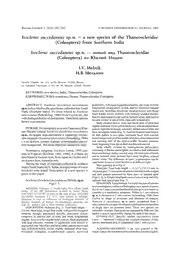
Isoclerus succedaneus sp.n. — a new species of the Thanerocleridae (Coleoptera) from Southern India PDF
Preview Isoclerus succedaneus sp.n. — a new species of the Thanerocleridae (Coleoptera) from Southern India
Russian Entomol. J. 14(4): 281–282 © RUSSIAN ENTOMOLOGICAL JOURNAL, 2005 Isoclerus succedaneus sp.n. – a new species of the Thanerocleridae (Coleoptera) from Southern India Isoclerus succedaneus sp.n. — íîâûé âèä Thanerocleridae (Coleoptera) èç Þæíîé Èíäèè I.V.Melnik È.Â.Ìåëüíèê General Glagolev str., 6/1, ap.50, Moscow 123448, Russia. ул. генерала Глаголева, д. 6/1, кв. 50, Москва 123448, Россия. KEYWORDS: new species, India, Thanerocleridae, Coleoptera. КЛЮЧЕВЫЕ СЛОВА: новый вид, Индия, Thanerocleridae, Coleoptera. ABSTRACT. Isoclerus (Isoclerus) succedaneus posteriorly; with equal rugged punctuation, one weak oviform sp.n. is described on the specimens, collected into Tamil longitudinal emargination on disk, and two indistinct rounded Nadu (Southern India). It's close related to Isoclerus lateral pits. Scutellum bicolored, chestnut-brown with broad tuberculatus (Schenkling, 1906) from Ceylon Isl., but black border. Elytra oviform, with obtusely rounded humeri; heavily punctuated except narrow humeral areas, punctuation well distinguished by elytral pattern. These both species became weaker in apical third, especially in band area. form a vicariant pair. Body chestnut-brown, frons and lateral parts of pronotum slightly darkened. Elytra yellowish-brown, with developed black РЕЗЮМЕ. По материалу из штата Тамилнад (Юж- pattern, light lateral margin, anteriorly dilated sutural stripe and ная Индия) описан Isoclerus (Isoclerus) succedaneus three incomplete bands (Fig.5). Anterior humeral band broken sp.n., по форме переднеспинки и характеру опуше- by dark pattern to two spots, mid-band fused with external ния сходный с Isoclerus tuberculatus (Schenkling, 1906) lateral margin in front of the middle of elytron, directed posterial с о-ва Цейлон, однако хорошо отличющийся рисун- and reaching half of the elytron’width; broadest posterior ком надкрылий. Эти виды образуют викарную пару. band, beginning from apical third and directed anterial. Body wholly covered by heterogeneous pubescence, Nominative subgenus Isoclerus Lewis, 1939 con- consisting of thinner and brighter, inclined or half-adherened sists of 9 species [Kolibá , 1992, 1998], 6 of them are hairs and thicker, darker erected setae. On inner part of bands distributed in Eastern Asia, from Japan to Ceylon and 3 and in humeral areas inclined hairs more brighten, seemed almost white. The difference in hairs’ pigmentation can be are known from Australia only. seen better in native (wet) beetles or in diffused light. During the study of materials collected in southern Male genitalia as in Fig. 4. India (Tamil Nadu) by S.Saluk, two specimens of a new Paratypes: Total body length — 3.1 (#), 3.8 ($) mm. In Isoclerus were found. Description of a new species is one paratype (#) inner parts of anterior and mid-bands merged given in this paper. and dark pattern presented by three pairs of isolated spots (Figs 2, 6), in females hind band reach of sutural strip and fully Isoclerus (Isoclerus) succedaneus Melnik, sp.n. separate dark apical spot (Fig. 7). Figs 1–7. DIAGNOSIS. Tarsal formula 5-4-4 and structure of antenna is an unambiguent evidence of belonging a new species to genus MATERIAL. Holotype: #, South India, West Ghats, Tamil Isoclerus. Large eyes and bicolored elytron give us a reason to Nadu, 35 km SW Kodaikanal, h~2060 m, Kukal Shola, consider it a nominative subgenus. Within it I.succedaneus N10°16’23” E77°21’55”, in moss on the stem of tree, 30.XI.2003 sp.n. is closeness to I. tuberculatus (Schenkling, 1906) from leg.S.Saluk; Paratypes: 1 # 2$$, same labeled as holotype. Ceylon by shape of pronotum and character of setation. Holotype is kept in collection of Zoological Institute of Russian Academy of Science (St.-Petersburg), paratypes are However I. succedaneus sp.n. easily recognized from I. kept in author’s and S. Saluk (Minsk) collections. tuberculatus by strongly developed elytral pattern and position DESCRIPTION. Holotype (Fig. 1). Total body length — of bright hairs on posterior band. These two species are 2.8 mm. Head large, longer than width, with parallel elongated undoubtly vicariant, their areals are separated by Palk stait.The tempora; strongly punctuated dorsally, punctation closely further research can possibly change the rank of this taxon. connected in anterior part of frons and forms longitudinal ETYMOLOGY. Specific epithet succedaneus (from rugulae. Eyes overflowing the head’contour, black pigmented Latin — “substitute”) reflects the vicariant character of new with large phacetes. Antenna 11-segmented, with distinct 3- species distributed area in comparison with I.tuberculatus. segmented club. Maxillary and labial palps, antennomeres and legs yellowish-brown, except slightly darkened tibial base. ACKNOWLEDGEMENT. I am very grateful to Mr. Pronotum elongated, scyphiformed, equally narrowed Artem Zaitsev for translation of text from Russian into English. 282 I.V.Melnik 4 5 6 7 1 2 3 Figs 1–7. Isoclerus succedaneus sp.n.: 1–3 — habitus (1–2 — dorsal view, 3 — ventral view); 4 — male's genitalia; 5–7 — elytral pattern; 1, 4–5 — holotype; 2–3, 6–7 — paratypes; 1–6 — #; 7 — $. Ðèñ. 1–7. Isoclerus succedaneus sp.n.: 1–3 — âíåøíèé âèä (1–2 — ñâåðõó, 3 — ñíèçó); 4 — ñòðîåíèå ãåíèòàëèé ñàìöà; 5–7 — ñõåìà ðèñóíêà íàäêðûëèé; 1, 4–5 — ãîëîòèï; 2–3, 6–7 — ïàðàòèïû; 1–6 — #; 7 — $. References Kolibá J. 1998. New Australian Thanerocleridae, with notes on Corporaal J.B. 1939 (1938). Revision of the Thaneroclerinae the subtribe Isoclerina Koliba (Coleoptera, Cleroidea) // (Cleridae, Col.) // Bijdr. Dierk. Vol.27. P.347–363. Invert. Taxon. Vol.12. No.6. P.951–975. Kolibá J. 1992. Revision of Thanerocleridae n.stat. (Co- Schenkling S. 1906. Die Cleridae des Deutschen Entomologi- leoptera, Cleroidea) // Mitt. Schweiz. Entomol. Ges. Bd.65. schen National-Museums, nebs Beschreibungen neuer Arten S.303–340. // Deutsch. Ent. Zetschr. Bd.50. Hf.1. S.241–320.
